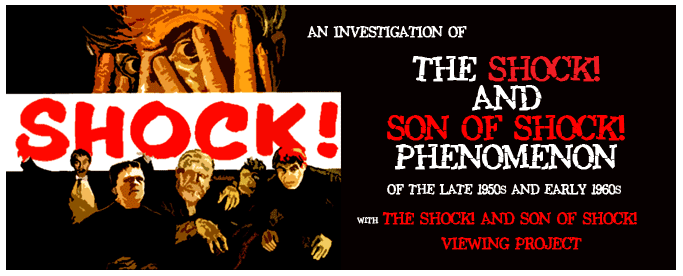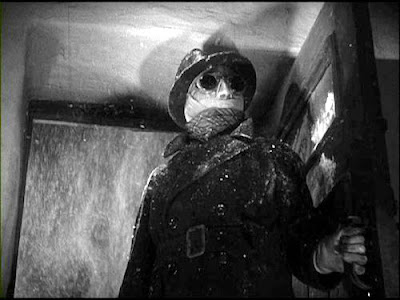THE CREEPING BRIDE: Probably as a result of the popularity of SHOCK!, rumors began to spread in 1958 that a number of horror and sci-fi shows were being planned for the new Fall season. When autumn came, some TV writers mentioned how surprised they were that so few of these programs actually turned up on the small screen. One of those that did was a half-hour British television series that had been picked up by CBS called "The Invisible Man." CBS first began airing it in early November 1958, not too long after Universal's THE INVISIBLE MAN first appeared on TV as part of SHOCK! films.
Directly below that listing, this movie theater double-feature ad appeared:
Unlike
Universal's remarkable horror film of the same name, the TV series "The
Invisible Man" was a fantasy-spy show. Rather than a crazed chemist
going on a murderous rampage, the scientist in the television series is a
respectable, trusted, and stable chap who agrees to do Cold War
missions for British intelligence after he has been irreversibly
rendered transparent in a lab accident involving radioactive materials.
Originally, CBS had intended to follow "The Invisible Man" on Wednesday
nights with a second fantasy-spy series called "World of Giants";
produced by Ziv, "World of Giants" featured a secret agent who had been
miniaturized down to six inches following his exposure to experimental
missile fuel while behind the Iron Curtain, an obvious take-off on THE
INCREDIBLE SHRINKING MAN (1957). The pairing of "The Invisible Man" and
"World of Giants" on CBS never happened because of the programming
emergency that erupted in 1958 when a series of corruption scandals connected to TV quiz shows
forced abrupt cancellations that had networks scrambling to fill slots.
("World of Giants" ended up being first-run in syndication in Fall 1959
rather than on network telecast.)
"The Invisible Man" show was the creation of Ralph Smart, who later went on to make the great "Danger Man" ("Secret Agent" in the US) series with Patrick McGoohan. A young Brian Clemens worked as a writer on "The Invisible Man," as well; Clemens is responsible for a number of classic action-adventure British TV series of the 1960s and 1970s, such as "The Avengers," "The Protectors," "The Professionals," and "The Persuaders." Despite such an impressive pedigree, however, "The Invisible Man" didn't impress: one syndicated TV columnist dismissed it out of hand as "juvenile" fare, while another writer for UPI called it "really more of a short-circuit" than "a shocker." The critic goes on to say that "it's not that there isn't a kernel of an idea in the Invisible Man bit. Witness the crackly old Claude Rains movie." The TV series, however, is "completely uncrackly" because the writing "is simply absurd-- heavy-footed and clodpated."
"The Invisible Man" show was the creation of Ralph Smart, who later went on to make the great "Danger Man" ("Secret Agent" in the US) series with Patrick McGoohan. A young Brian Clemens worked as a writer on "The Invisible Man," as well; Clemens is responsible for a number of classic action-adventure British TV series of the 1960s and 1970s, such as "The Avengers," "The Protectors," "The Professionals," and "The Persuaders." Despite such an impressive pedigree, however, "The Invisible Man" didn't impress: one syndicated TV columnist dismissed it out of hand as "juvenile" fare, while another writer for UPI called it "really more of a short-circuit" than "a shocker." The critic goes on to say that "it's not that there isn't a kernel of an idea in the Invisible Man bit. Witness the crackly old Claude Rains movie." The TV series, however, is "completely uncrackly" because the writing "is simply absurd-- heavy-footed and clodpated."
 I
admit that I wasn't too sure what was meant by "crackly" in this
context, but after looking it up (I also had to look up "clodpated,"
which I first read as "coldplated," for some reason), I think that it is
a good adjective to describe Uni's THE INVISIBLE MAN: the writing of
the dialogue and the action is crisp, sharp, sprightly, neat, and
clever. Even on television and interrupted with commercials, the movie
clips along nicely and keeps you engaged. The same can't be said of the
episodes of "The Invisible Man" that I watched on-line-- television, of
course, has always been (and still is) a stiflingly conservative medium,
so it's probably unfair in the first place to even think that a TV show
about a heroic British spy could compete with the late-night movie
lunacy of this James Whale motion picture.
I
admit that I wasn't too sure what was meant by "crackly" in this
context, but after looking it up (I also had to look up "clodpated,"
which I first read as "coldplated," for some reason), I think that it is
a good adjective to describe Uni's THE INVISIBLE MAN: the writing of
the dialogue and the action is crisp, sharp, sprightly, neat, and
clever. Even on television and interrupted with commercials, the movie
clips along nicely and keeps you engaged. The same can't be said of the
episodes of "The Invisible Man" that I watched on-line-- television, of
course, has always been (and still is) a stiflingly conservative medium,
so it's probably unfair in the first place to even think that a TV show
about a heroic British spy could compete with the late-night movie
lunacy of this James Whale motion picture.In addition to the crackly writing, you also have to marvel at some of the performances that Whale drew from his cast. Claude Rains' Jack Griffin dominates the proceedings with his manic mood swings from growling threats to hysterically over-the-top proclamations ("Even the Moon is frightened of me!"), all of which is punctuated by his tittering cackles and megalomaniacal braying. I find these outbursts to be equally unnerving and funny during his freak-outs, and it's hard to keep your eyes off of this see-through terrorist. But I also really like William Harrigan's performance as Kemp in the almost totally wordless scenes when he first encounters the unseen naked maniac. Harrigan's physical reactions as he interacts with another actor that is not actually in his study (as well as the later scene where he walks from the car to the Lion's Head to retrieve Griffin's notebooks) is a very convincing performance (Harrigan's later hysterical scenes with the police aren't at all as interesting).
 Whale's
film is dense with these kinds of fabulous things, all of which add up
to make THE INVISIBLE MAN so compellingly watchable. Watering all that
down into a half-hour spy show is just a bad idea all around since
comparisons would be inevitable, and one needed only turn in to SHOCK!
to see the superior original.
Whale's
film is dense with these kinds of fabulous things, all of which add up
to make THE INVISIBLE MAN so compellingly watchable. Watering all that
down into a half-hour spy show is just a bad idea all around since
comparisons would be inevitable, and one needed only turn in to SHOCK!
to see the superior original.
A
final note: the other day I saw TCM's annual musical memorial montage
listing many of the prominent film folks who have passed away during the
previous year. Naturally, TCM editors chose something from TITANIC to
commemorate Gloria Stuart (who died in late September at the age of 100)
and that's a completely understandable decision. But wouldn't it have
been great to show her in THE OLD DARK HOUSE, SECRET OF THE BLUE ROOM or
THE INVISIBLE MAN? Whale doesn't give her much to do in THE INVISIBLE
MAN except look luminescent and outrageously desirable, but she does
that so well...
* * *
Trailer and Ads
A fan produced trailer by Jeff Hollis and Eric Stormoen.
The Star Press, March 11, 1934
The Akron Beacon Journal, Dec 15, 1933


























































